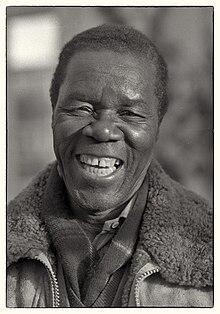Shona sculptures
Shona sculptures is the name for sculptures in older and contemporary African art . It includes expressive stone sculptures, especially serpentinite or verdite , depicting people, animals and mythical creatures.
term
Almost three quarters of the population of present-day Zimbabwe and earlier Rhodesia are known as Shona . In fact, there are six main peoples, the Kore Kore, Zezuru, Katanga, Manyika, Ndau and Rozvi, some of which also settle in today's neighboring states. They all belong to the language group of the Bantu peoples, but ethnologically they cannot be described as one people. The name "Shona" was coined in the 19th century by the Ndebele tribe , the second largest population group, as a kind of disparaging collective term for all non-Ndebele peoples and adopted by the colonial powers . The common language, today one of the official languages of Zimbabwe, was first introduced by missionaries as a lingua franca in spoken and written form in the 1930s. Also artists of other ethnicities , e.g. B. the Chewa , work today as a sculptor in Zimbabwe.
Development, geology
Shona sculpture is a revived artist movement that originated in what was then Rhodesia , now Zimbabwe, between the 1950s and 1960s . The founder of modern sculpture is Joram Mariga from Nyanga . He began artistic stone processing in 1958. The director of the National Gallery in what was then Salisbury , Frank McEwen , promoted these activities. As a result, the stone carving group developed in this place.
Tom Blomefield , a former chrome ore miner born in Johannesburg , moved to Zimbabwe for professional reasons. In 1966 he founded an artists 'colony on his abandoned tobacco farm in Tengenenge , from which the associated artists' movement spread around the world. The Tengenenge settlement is located in the northern part of the country, in the province of Mashonaland Central , about 19 kilometers west of the small town of Centenary .
McEwen bought the Vukutu farm (east of Harare) in 1967 and started a similar project that developed competitively. Even so, Tengenenge remained the primary center.
The artistic processing of serpentinite and other rocks is also carried out in other regions of the country. In southern Africa, certain types of phyllosilicatic rocks, which are a form of the green schist facies and are associated with serpentinite masses, are called verdite . The Verdit deposits of Zimbabwe are in the locality of O'Brien. Soapstone is also used by the artists and appears in Nyanga, Mutare , Masvingo and Kwekwe .
distribution
Field workers became artists whose fame today extends beyond the borders of Africa. The modern Shona sculptures have become known worldwide within a few decades. The first group exhibition took place in 1962 within the International Congress of African Culture in Salisbury (now Harare). Further presentations followed in 1968 in Lusaka, Kampala and New York, in Paris in 1971 and in London in 1972.
Zimbabwean stone sculptures - also generally referred to as Shona sculptures - have been exhibited in renowned museums and galleries around the world, such as the Museum of Modern Art in New York, the Center Pompidou and the Musée Rodin in Paris, the Museum of Ethnology in Frankfurt a. M., at the Venice Biennale or the Expo 2000 in Hanover, as well as by specialized galleries, especially in the USA and Europe.
Sales exhibitions are organized by galleries in cooperation with the Zimbabwean art and gallery centers, preferably in botanical gardens, palace parks and at African cultural festivals in Europe.
literature
- Harald Olbrich (Ed.) Et al .: Lexikon der Kunst, Vol. 6 . Leipzig (EA Seemann) 1994 ISBN 3-363-00049-9
- WR Oosterhuis: Stone in Southern Africa . Paris 1999. ISBN 88-8138-044-7
- Eckart Rohde, Helmut Rohde: Animated Stones - Sculptures from Zimbabwe. Hamburg 1998. ISBN 978-3-8258-3837-9
- TL Webb et al .: Handbook of South African Natural Building Stone . Cape Town 1967.
Web links
Individual evidence
- ↑ Eberhard Schnake: Spirits in Stone. Stone sculptures from Zimbabwe . Munster 2003.






